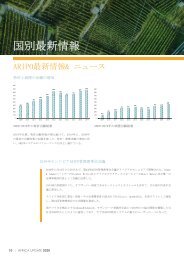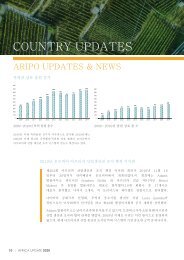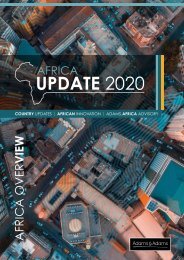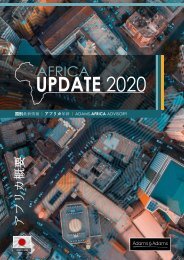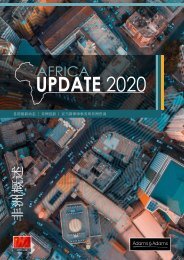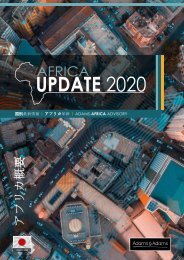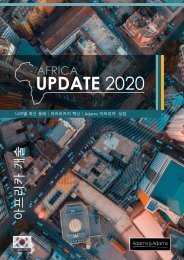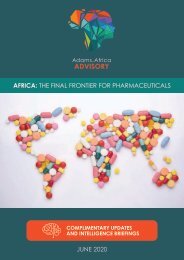Adams Adams Advisory Insights - May 2020
Helping guide strategic business decisions in Africa, Adams.Africa Advisory brings you detailed updates and intelligence briefings to keep you up-to-date and well-informed on all economic, business, and political developments from across the continent. Detailed monthly highlight packages offer insights into the latest changes and key trends in all of Africa’s jurisdictions, together with pressing ad-hoc updates, providing clients with accurate information, and a precise framework for brand expansion and IP protection. Adams.Africa Advisory comprises an expert team with first-hand experience and knowledge, offering clients a diverse range of critical service offerings. https://www.adams.africa/advisory-insights/
Helping guide strategic business decisions in Africa, Adams.Africa Advisory brings you detailed updates and intelligence briefings to keep you up-to-date and well-informed on all economic, business, and political developments from across the continent.
Detailed monthly highlight packages offer insights into the latest changes and key trends in all of Africa’s jurisdictions, together with pressing ad-hoc updates, providing clients with accurate information, and a precise framework for brand expansion and IP protection.
Adams.Africa Advisory comprises an expert team with first-hand experience and knowledge, offering clients a diverse range of critical service offerings.
https://www.adams.africa/advisory-insights/
Create successful ePaper yourself
Turn your PDF publications into a flip-book with our unique Google optimized e-Paper software.
AFRICA’S ENERGY DEVELOPMENTS<br />
COMPLIMENTARY UPDATES<br />
AND INTELLIGENCE BRIEFINGS<br />
MAY <strong>2020</strong><br />
1
TABLE OF CONTENTS<br />
Africa INSIGHTS<br />
P. 03<br />
NEW TECHNOLOGY AND WEAK FOSSIL FUEL INVESTMENT<br />
PAVE WAY FOR RENEWABLES AND GREATER<br />
INTERCONNECTION OF REGIONAL POWER POOLS<br />
Improvements and innovations: progress made in the energy transition ................................. 03<br />
Priorities and opportunities leading up to 2030 ............................................................................ 04<br />
Key considerations .......................................................................................................................... 07<br />
Africa’s top 10 stories<br />
P. 08<br />
1. Vodacom, Safaricom partner in purchase of Kenyan fintech brand M-pesa ................... 08<br />
2. Nigeria’s leading bank implements voice operated banking service ............................... 08<br />
3. West Africa embarks on solar power electrification scheme .............................................. 09<br />
4. Bannerman tests nano filtration technique at Etango uranium project .............................. 09<br />
5. Fintech app Chippercash partners with Visa for expansion drive ....................................... 10<br />
6. Nigerian genomics company secures additional funding for scaling research ............... 10<br />
7. Innovation hubs launch in South Africa and Morocco ......................................................... 10<br />
8. Locally manufactured modular chips revolutionising IoT ..................................................... 11<br />
9. Iron Capital announces partnership with Australian government ....................................... 11<br />
10. AfDB and Others Pledge US$160 Million to Improve Africa’s Energy Access ..................... 11<br />
Other notable stories ....................................................................................................................... 11
Africa INSIGHTS<br />
NEW TECHNOLOGY AND WEAK FOSSIL FUEL INVESTMENT PAVE WAY FOR RENEWABLES<br />
AND GREATER INTERCONNECTION OF REGIONAL POWER POOLS<br />
The trajectory of Africa’s energy developments can broadly be categorised under two main strategies. The first<br />
is grid intensification in contributing to the electrification of growing urban centres in covering roughly 45% of<br />
Africa’s projected energy needs by the middle of the century. This type of grid intensification has traditionally been<br />
buoyed by coal, natural gas and large-scale hydropower, but a confluence of factors, including environmental<br />
concerns, are throwing into question the future viability of this model. The second is the fast-tracking and rollout<br />
of micro-grids primarily based on renewable sources in stimulating rural electrification - here solar home systems<br />
will alleviate pressures on central grids while simultaneously paving the way for sustainable electrification.<br />
Though over a hundred coal-fired power plants are scheduled to be built in Africa by 2040, the funding for these<br />
may not materialise. Investor interest in coal-fired power has dropped dramatically, and the African Development<br />
Bank (AfDB) echoed the sentiment when it announced in June 2019 that it would not be financing any further<br />
projects of this type. Natural gas is becoming a preferred baseload power source particularly in Southern Africa,<br />
but also in pockets within West Africa like Cote d’Ivoire, Ghana, Nigeria and Senegal. Hydropower is a preferred<br />
alternative renewable baseload power source to both coal and gas, however the considerable initial buildinvestment<br />
required, long-lead time to completion, and overt reliance on water availability in what can be water<br />
scarce regions, have placed a limit on its future utility. Instead renewable energy installations tapping into wind,<br />
solar (both photovoltaic and concentrated solar power) and geothermal energy will play an increasing role<br />
going forward.<br />
Improvements and innovations: progress made in the energy transition<br />
Wind and solar technologies have proved the biggest winners of foreign financing and technical assistance<br />
thanks to lower costs, with their use spreading beyond their dominant presence in North and Southern Africa.<br />
Once reliant on oil and gas for their energy requirements, North African countries have made strides toward<br />
incorporating solar into their energy mixes, initialising a host of plants including the 1.8GW Bembam park in Egypt,<br />
the 4.5GW Tunur project in Tunisia, 150MW worth of projects in Algeria, and the 2GW Ouarzazate Noor solar<br />
project in Morocco. South Africa gained a boost to its renewables sector when it was announced in early <strong>2020</strong><br />
that regulators would loosen restrictions on independent power producers (IPPs) in allowing additional support<br />
to ailing national utility Eskom.<br />
3
AFRICA INSIGHTS<br />
The biggest new growth in renewables has emerged from the West and East African regions<br />
respectively. ECOWAS nations have seen the renewable portion of their energy mix expand<br />
dramatically over the past two years, with five new solar plants built in Senegal since 2018<br />
and similar projects underway in Mali. The AfDB has additionally launched a financial support<br />
mechanism for rural electrification projects in Cote d’Ivoire, Guinea and São Tomé and Príncipe.<br />
East Africa has seen the proliferation of a variety of renewables including geothermal projects in the Rift Valley,<br />
wind farm projects in Ethiopia, Kenya, Tanzania and Uganda, and planned ‘run of river’ hydropower projects<br />
across Burundi, Kenya and the DRC.<br />
In addition to the shifting focus toward renewables the past two years have seen committed efforts by regional<br />
partners to further advance energy trade in and between regional power pools. The Maghreb Electricity<br />
Committee (COMELEC) is the continental leader in this regard with Morocco and Tunisia both intending to sell<br />
power to European nations via undersea transmission cables. Members of the East African Power Pool (EAPP)<br />
have been trading power amongst each other since 2018 following the construction of six major transmission<br />
lines between member states. In the same year Tanzania received a US$455 million funding package for the<br />
construction of a transmission project which links the EAPP and the Southern African Power Pool (SAPP), while in<br />
September 2019 the World Bank helped fund the Malawi-Mozambique interconnector, with additional projects<br />
for linkages between the DRC and Zambia also underway. The West African Power Pool (WAPP) will begin trading<br />
energy across borders by the end of <strong>2020</strong> through an active IPP market in Ghana and privatised transmission<br />
infrastructure in Nigeria.<br />
Source: PIDA, Ketraco, ESI-Africa, Prime Investment Limited; 2018-<strong>2020</strong><br />
Priorities and opportunities leading up to 2030<br />
Thanks to reductions in cost and newfound ease of scalability the notion of renewables playing an integral role in<br />
powering national and regional grids is becoming increasingly palatable to international investors. Development<br />
priorities have shifted towards making the energy mix of renewables and non-renewables more efficient and<br />
easy to manage, providing a conducive platform for building an efficient and digitised renewable energy grid<br />
from the ground up. Opportunities over the coming years are likely to focus on aspects such as better utilising Big<br />
4
AFRICA INSIGHTS<br />
Data and the internet of things (IoT), improving battery storage capacity, implementing smart<br />
grid development through artificial intelligence (AI), and streamlining the transfer and sale of<br />
electricity through blockchain technology.<br />
Advancements in battery storage are the key avenue by which renewables have managed<br />
to compete with oil, gas and coal for utility scale applications. These instances have been<br />
generally confined to developed countries including Japan, Germany, UK, US and other EU member states,<br />
however analysts predict that their application will drive growth of at least 45% percent year-on-year in emerging<br />
markets between now and 2025. Battery-storage systems including lithium-ion, sodium-ion, sodium sulphur and<br />
vanadium redox, can serve as vital components in the interplay between renewables and fossil fuels as they<br />
remove inefficiencies and manage output by storing energy during peak production and releasing during peak<br />
demand. In smaller contexts they can drive down costs for individual consumers in micro-grid operations through<br />
the use of ‘behind-the-meter-systems’. In a grid intensification context they remove inefficiencies by harmonising<br />
the intermittent supply of renewable energy with peaking and troughing demand of central grids. Such systems<br />
are in demand in countries like Burkina Faso, South Africa and Zimbabwe, where aging centralised grids suffer<br />
from frequent failures. In February <strong>2020</strong> the International Finance Corporation signed a deal with the Burkinabe<br />
government to begin rolling out such systems before the end of the year. The South African government has<br />
similarly adopted the Battery Energy Storage System (BESS) which has already been deployed in small scale<br />
at the Sere wind energy facility. Across the border in Zimbabwe, Distributed Power Africa has employed Tesla<br />
battery systems in its cell towers and sold units to local firms to mitigate against rolling blackouts.<br />
Shepherding a mixed generation and supply of renewable and non-renewable sources to cyclically coincide<br />
with demand and generation peaks across national and regional boundaries, will quickly become too complex<br />
to do efficiently, and this is where the deployment of AI systems will come to the fore. The development of 5G<br />
technology will also allow IoT systems to rapidly analyse and share information about the state and usage of<br />
electricity, and when coupled with AI can provide an analytical element with the capacity to gauge and predict<br />
future demand needs and preemptively inform energy operators of supply requirements and maintenance.<br />
When combined with blockchain technology it will allow for the tabling of secure databases on billing and tariffs,<br />
allowing for dynamic energy trading across regions in keeping with demand at the lowest cost to producers and<br />
consumers. Smart meters will also greatly aid national power utilities in revenue collection, which has historically<br />
been an obstacle in practically all African countries. The EAPP, SAPP and WAPP will have a particular need for<br />
such systems in the near future as more and more renewable energy is fed into the grid and increasingly changes<br />
hands across borders. Africa’s two biggest economies, Nigeria and South Africa, have already begun to deploy<br />
these in a limited capacity, with 2015-startup The Sun Exchange launching the peer-2-peer solar leasing market<br />
for photovoltaics in South Africa and RA365 employing the use of AI to plot the best locations for deployment of<br />
solar tech in Nigeria.<br />
5
AFRICA INSIGHTS<br />
TOP POWER PRODUCERS IN AFRICA: KEY DATA BY MARKET<br />
MARKET<br />
ENERGY PRIORITIES<br />
RENEWABLE<br />
ENERGY<br />
FOCUS<br />
GENERATION<br />
CAPACITY<br />
AND % OF<br />
POPULATION<br />
WITH ACCESS<br />
MAIN PLAYERS IN THE MARKET<br />
PROMINENT IPPS<br />
South Africa<br />
• Cost reduction,<br />
• Rural electrification<br />
• Grid reliability<br />
• Biogas<br />
• Solar<br />
• Wave<br />
• Wind<br />
51.3 GW<br />
(94%)<br />
Eskom Ltd<br />
• RCL Foods<br />
Sugar & Milling<br />
• Kelvin Power<br />
• Mondi<br />
Egypt<br />
• Energy security<br />
• Cost reductions<br />
• Biomass<br />
• Hydro<br />
• Solar<br />
21.0 GW<br />
(99.9%)<br />
• Egyptian Electricity Holding Co.<br />
• Egyptian Electricity Transmission Co.<br />
• Ras Ghareb<br />
Wind Energy<br />
S.A.E<br />
Nigeria<br />
• Energy security<br />
• Cost reduction<br />
• Rural electrification<br />
• Biogas<br />
• Hydro<br />
• Solar<br />
• Wind<br />
12.5 GW<br />
(60%)<br />
• The Power Holding Company of<br />
Nigeria<br />
• Niger Delta Power Holding<br />
company<br />
• Transmission Company of Nigeria<br />
• Egbin Power<br />
• Sapele Power<br />
• Afam Power<br />
• Ughelli Power<br />
Ghana<br />
• Cost reduction<br />
• Rural electrification<br />
• Grid reliability<br />
• Solar<br />
• Hydro<br />
• Wind<br />
4.0 GW<br />
(84%)<br />
• Volta River Authority<br />
• Ghana Grid Company Limited<br />
• Electricity Company of Ghana<br />
Limited<br />
Genser Power<br />
Ethiopia<br />
• Generation capacity,<br />
• Transmission & Distribution<br />
infrastructure<br />
• Solar<br />
• Hydro<br />
• Wind<br />
3.7 GW<br />
(45%)<br />
• Ethiopian Electric Power<br />
Corporation<br />
Mozambique<br />
• Generation capacity<br />
• Transmission & Distribution<br />
infrastructure<br />
• Hydro<br />
• Solar<br />
• Wind<br />
2.8 GW<br />
(29%)<br />
• Electricidade de Moçambique<br />
• Hidroeléctrica de Cahora Bassa<br />
• Mozambique Transmission<br />
Company<br />
Central Termica<br />
de Ressano<br />
Garcia (CTRG)<br />
Kenya<br />
• Grid reliability<br />
• Cost reduction<br />
• Geothermal<br />
• Solar<br />
• Wind<br />
2.3 GW<br />
(75%)<br />
• Kenya Electricity Generating<br />
Company<br />
• Kenya Power and Lighting<br />
Company<br />
• Kenya Transmission Company<br />
Tembo Power<br />
The Democratic<br />
Republic of<br />
Congo<br />
• Generation capacity<br />
• Transmission & Distribution<br />
infrastructure<br />
• Biogas<br />
• Geothermal<br />
• Hydro<br />
• Solar<br />
2.0 GW<br />
(8.7%)<br />
Société nationale d’électricité<br />
Tembo Power<br />
Tanzania<br />
• Generation capacity<br />
• Transmission & Distribution<br />
infrastructure<br />
• Grid reliability<br />
• Rural electrification<br />
• Biogas<br />
• Geothermal<br />
• Hydro<br />
• Solar<br />
• Wind<br />
1.5 GW<br />
(36%)<br />
Tanzania electric Supply Company<br />
Songas<br />
Senegal<br />
• Generation capacity<br />
• Energy security<br />
• Transmission & Distribution<br />
infrastructure<br />
• Rural electrification<br />
• Solar<br />
• Wind<br />
0.8 GW<br />
(68%)<br />
SENELEC<br />
• Senergy<br />
• Wärtsilä<br />
Source: IRENA, US AID, IEA, Various; 2016-<strong>2020</strong><br />
6
AFRICA INSIGHTS<br />
Key considerations<br />
Effective policy-making by African governments remains the biggest challenge to the greater<br />
integration of IPPs going forward. Local content laws, which new industrial and infrastructure<br />
projects generally require, have been implemented in Ghana and South Africa and have<br />
increased the cost of investment. Furthermore, the fiscal challenges faced by African governments in general,<br />
and their national power utilities in particular, have raised political appetites to change the “pay or take<br />
model” which guarantees IPPs tariffs regardless of their usage on the national grid. The model risks raising costs<br />
substantially and would contravene with EU free trade policy, which increases the potential of Africa’s biggest<br />
renewable energy partners withholding investments. Furthermore, at this stage in time achieving profitability with<br />
microgrids remains a challenge, especially for early market entrants in untapped rural areas due to the limited<br />
buying power of local customers and lack of supporting infrastructure.<br />
It’s important to note that renewables are still in their infancy concerning utilisation in Africa compared to mature<br />
markets like the EU. Utility scale implementation in Africa is still some years away with subsidies still incentivising<br />
small scale plants. Motivations for their implementation also differ. Whereas renewables represent ecologically<br />
friendly alternatives to energy security in the EU, in Africa the impetus still lies on generative capacity, costsaving<br />
and job creation, which in the eyes of African heads of state require a differing approach to project<br />
implementation in local markets.<br />
7
Africa’s top 10 stories<br />
1<br />
VODACOM, SAFARICOM PARTNER IN PURCHASE OF KENYAN FINTECH BRAND<br />
M-PESA<br />
Kenya’s two largest telecommunications companies, Vodacom and Safaricom, have<br />
successfully acquired fintech platform M-Pesa from UK-based telecoms provider, Vodafone. The<br />
US$13.4 million deal enables these two African-based firms to eliminate the need to pay 5% and<br />
2% respectively for every transaction completed by their users on M-Pesa. With full brand rights,<br />
the new owners are free to devise their own strategy for the platform, expanding it into new<br />
markets. M-Pesa has 40 million users across the continent with Kenya alone accounting for close<br />
to two-thirds. Outside of Kenya, M-Pesa has a presence in the Democratic Republic of Congo,<br />
Egypt, Lesotho, Ghana, Mozambique and Tanzania. Mobile money is one of Africa’s fastest<br />
growing industries, with the GSMA estimating a sector entry of 500 million new customers before<br />
the end of the year.<br />
2<br />
NIGERIA’S LEADING BANK IMPLEMENTS VOICE-OPERATED BANKING SERVICE<br />
Zenith Bank, Nigeria’s leader in customer service, has become the first bank in the country to<br />
implement voice-operated banking services. The self-service product offers quick response to<br />
customers, in addition to security entrenched by a multilayer authentication mechanism. This<br />
offering has come at a critical time, with physical distancing regulations and lockdowns in some<br />
of Nigeria’s states preventing customers from accessing banking services in more conventional<br />
ways. The country’s top banks have made service automation a priority over the last two<br />
years, streamlining their services to enable agile responses to more complex, higher priority<br />
customer needs. Nigerian banks such as Zenith are well positioned to remain competitive as<br />
the local market consolidates operations and the Central Bank of Nigeria mulls over industry<br />
recapitalisation plans.<br />
Financial services automation processes<br />
Source: Finovate, Automation Academy; <strong>2020</strong><br />
8
AFRICA’S TOP 10 STORIES<br />
3<br />
WEST AFRICA EMBARKS ON SOLAR POWER ELECTRIFICATION SCHEME<br />
A Finnish research team confirmed in a report early this month that solar grids,<br />
assisted by battery storage technology, will take a leading role in West Africa’s<br />
energy mix by 2050. This has come amid an intensive campaign by the African<br />
Development Bank to roll out micro-grid solar electrification schemes for rural<br />
communities in ECOWAS countries, where half of all citizens do not have regular, stable access to<br />
electricity. Côte d’Ivoire received a EU62 million grant for electrification, Sao Tome and Principe<br />
EU12 million, and Guinea EU630 000. In early 2019, ECOWAS nations announced that they would<br />
be allowing for the purchase and sale of energy across borders in contribution to the West<br />
African Power Pool by the end of <strong>2020</strong>.<br />
4<br />
BANNERMAN TESTS NANO FILTRATION TECHNIQUE AT ETANGO URANIUM PROJECT<br />
Bannerman, which operates the Etango uranium project in Namibia, is in the process of rolling<br />
out a new nano-filtration technique which, in collaboration with an ion exchange process, will<br />
more efficiently filter out iron ore to achieve purified uranium ore. This is one of the more recent<br />
measures by the company, aimed at cost-cutting amid subdued global demand. The price of<br />
uranium has however rebounded by 33% since January <strong>2020</strong> due to Covid-19-related supply<br />
chain disruptions and innovations in the sector have begun to revive. 2030 global nuclear energy<br />
production is expected to rise to 462 GW and by 2040, to 569 GW. Key African uranium mining<br />
projects currently in operation include: the Kayelekera uranium mine in Malawi, the Madaoela<br />
uranium project in Niger, and the Rossing and Husab mines in Namibia.<br />
Top producers - % share of<br />
global production<br />
Global nuclear energy demand<br />
scenario projections - Gigawatts<br />
Source: World Nuclear Organisation, 2019<br />
9
AFRICA’S TOP 10 STORIES<br />
5<br />
FINTECH<br />
APP CHIPPERCASH PARTNERS WITH VISA FOR EXPANSION<br />
DRIVE<br />
Visa has partnered with mobile money service Chippercash for its expansion<br />
plans within and outside the continent. The company raised funding of US$8<br />
million in late 2019 for an ambitious Southern Africa expansion plan, after<br />
penetrating the major economies in West and East Africa including: Ghana, Kenya, Nigeria,<br />
Rwanda, Tanzania and Uganda, procuring over a million customers along the way. Chipper<br />
finds its competitive advantage over other mobile money products in cross-border usability,<br />
allowing for peer-to-peer transactions between countries when many of its competitors only<br />
allow transactions over limited geographical locations. This functionality will greatly benefit from<br />
its partnership with Visa, whose infrastructure allows for such services.<br />
6<br />
NIGERIAN<br />
GENOMICS COMPANY SECURES ADDITIONAL FUNDING FOR SCALING<br />
RESEARCH<br />
54gene, a Nigerian based pharmaceutical company, has secured Series A funding worth US$15<br />
million. The funding is led by Adjuvant Capital, a life sciences fund backed by the IFC, Novartis,<br />
and the Bill & Melinda Gates Foundation. Launched in January 2019, 54gene seeks to use the<br />
untapped potential of African genomic data in therapeutic interventions. Up until 2018, only 3%<br />
of genetic material used by Genome-wide Association Studies (GWAS) was of African descent,<br />
placing people of African heritage at a distinct disadvantage in terms of pharmaceutical<br />
interventions. As part of its next stage of growth, the company will further explore partnerships<br />
and opportunities for the co-development of drug targets and therapeutics, expecting<br />
to partner with pharmaceutical, medical device and diagnostic companies for clinical<br />
programmes in Africa.<br />
R&D spending as a percentage of Development Goal<br />
recommendation of 1% of GDP<br />
Source: UNESCO Institute for Statistics, 2016-2017<br />
7<br />
INNOVATION<br />
HUBS LAUNCH IN SOUTH AFRICA AND MOROCCO<br />
Separate innovation hubs were launched earlier this month in two of Africa’s most advanced<br />
economies, South Africa and Morocco. South Africa’s financial regulators have launched<br />
the Intergovernmental Fintech Working Group (IFWG), hoping to ensure greater regulatory<br />
responsibility and consumer safety amid the recent explosion in the fintech market. The hub has<br />
cited the recent digitisation drive due to the Covid-19 pandemic as a key driver, highlighting<br />
the importance of their work in mitigating risks of spreading the virus. In Morocco, the Moroccan<br />
Employers’ Association (CGEM) and the International Finance Corporation (IFC) have teamed<br />
up to provide finance to digital start-ups. They have similarly cited that greater digitisation amid<br />
the Covid-19 epidemic will offer impetus to their operations and be something the organisation<br />
would be willing to support.<br />
10
AFRICA’S TOP 10 STORIES<br />
8<br />
LOCALLY MANUFACTURED MODULAR CHIPS REVOLUTIONISING IOT<br />
South African technology start-up Xinabox, is attempting to revolutionise the<br />
IoT industry through the development of modular components used for data<br />
collection in industrial, educational and recreational contexts. Their range<br />
of xChip modules encompasses processor boards, cores, sensors, power,<br />
communication, output, control and storage devices assembled and used without the addition<br />
of expensive tools that prove dangerous if used incorrectly, like soldering irons. xChip products<br />
have already been rolled out to schools in South Africa and the US, where the firm hopes they<br />
will assist in encouraging youngsters to embark on STEM careers. RS components, an international<br />
electronic components supplier, has been selling Xchip products globally since 2018 and the chips<br />
have seen various real-world applications including Antarctic research stations and satellites.<br />
9<br />
IRON CAPITAL ANNOUNCES PARTNERSHIP WITH AUSTRALIAN GOVERNMENT<br />
African-based investment bank Iron Capital has announced a partnership with the investment<br />
arm of the Australian government, Austrade. Austrade will assist in leveraging Iron Capital’s<br />
extensive network of local business contacts and vast expertise in financial advisory, corporate<br />
finance, project finance, market penetration strategies and regulatory advisory services, to<br />
source potential destinations for investment, with a special focus on Nigeria, Ghana, Kenya and<br />
Zambia. Australia’s share of investments in Africa has grown since 2015 and its companies are<br />
some of the major players in the West African mining space. Africa is also Australia’s main source<br />
of imported crude oil, mineral ores and motor vehicles.<br />
10<br />
AFDB AND OTHERS PLEDGE US$160 MILLION TO IMPROVE AFRICA’S ENERGY<br />
ACCESS<br />
The African Development Bank (AfDB), the European Union (KfW), the Clean Technology Fund<br />
(Norfund) and others have pledged US$160 million to the Facility of Energy Inclusion (FEI). This<br />
programme has been created to foster the development of small-scale energy networks and<br />
mini grids across the continent, with the aim of providing energy to rural communities. The facility<br />
is managed by the London based LHGP asset management group and has over US$400 million<br />
at its disposal. The fund specifically provides finance for independent power producers making<br />
use of renewable energy, including solar and wind technologies, to power their mini grids. Thus<br />
far the fund has aided ongoing electrification projects in Burundi, Cape Verde, Madagascar,<br />
Malawi and Mozambique.<br />
OTHER NOTABLE STORIES<br />
IMF PROVIDES FINANCIAL SUPPORT TO DEVELOPING COUNTRIES FIGHTING COVID-19<br />
The IMF has approved immediate financial support for 25 developing countries, 19 of which are African.<br />
Most are Least Developed Countrie’s from West and Central Africa, including Benin, Burkina Faso,<br />
Central African Republic, Guinea, Liberia, Madagascar and Togo.<br />
GLENCORE AND ZAMBIA REACH COMPROMISE OVER MINE CLOSURE<br />
International mining conglomerate Glencore has reached an agreement with the Zambian government<br />
to keep its mines open in the country following a protracted dispute which saw the local head of the<br />
firm arrested. Zambia is teetering on the edge of a debt crisis and any significant disruptions of copper<br />
exports could prove fatal to its national revenues.<br />
REPORT REVEALS THAT KENYANS SPEND MORE ON AIRTIME THAN ANYTHING ELSE<br />
A Kenya National Bureau of Statistics (KNBS) Consumer Price Index (CPI) survey has revealed that<br />
Kenyans spend more of their budgets on airtime than on any other expense, accounting for 5% of all<br />
spending. This new report has also shown the growing wealth of the middle class, with kerosene stoves<br />
and cassette players phased out in favour of mobile money transfers and university fees.<br />
11
12





